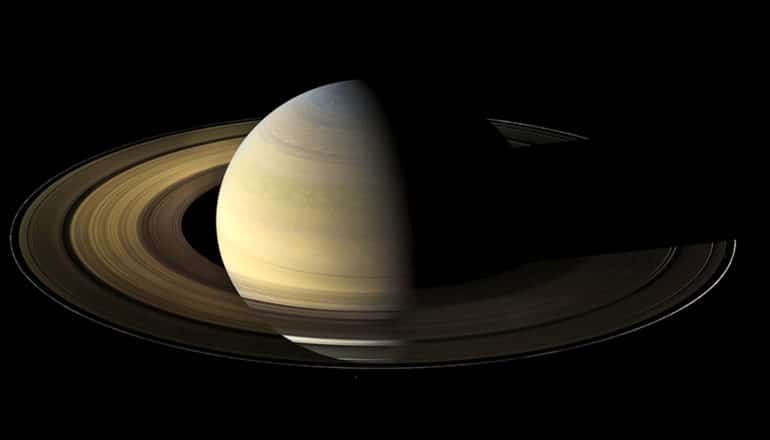
New experiments with lasers reveal evidence supporting the existence of helium rain inside planets composed primarily of hydrogen and helium, such as Jupiter and Saturn.
Scientists made the prediction nearly 40 years ago, but achieving the experimental conditions necessary to test the hypothesis has not been possible. That is, until now.
The new paper in Nature reveals evidence showing that helium rain—helium droplets falling through liquid metallic hydrogen, much like raindrops of water falling through the atmosphere on Earth—is possible over a range of pressure and temperature conditions that mirror those expected to occur inside planets such as Jupiter and Saturn.
The discovery will help scientists determine how such planets form and will provide key insight into the evolution of Earth and the solar system.
“Our experiments suggest that deep inside Jupiter and Saturn, helium droplets are falling through a massive sea of liquid metallic hydrogen,” says Gilbert (Rip) Collins, professor of mechanical engineering and associate director of science, technology, and academics at the Laboratory for Laser Energetics (LLE) at the University of Rochester.
“That is a pretty amazing thing to think about next time you look up at Jupiter in the night sky. This work will help us better understand the nature and evolution of Jupiter, which is particularly important as Jupiter has long been thought to have been somewhat of a space trash collector—protecting our planet in the solar system.”
To achieve the pressure and temperature conditions expected inside planets like Saturn and Jupiter, the researchers precompressed helium and hydrogen mixtures in a diamond anvil cell to pressures approximately 40,000 times the pressure of Earth’s atmosphere. They then the Omega Laser at the the LLE’s Omega Laser Facility to launch strong shock waves into the samples to further compress them and heat them to several thousand degrees.
Using a series of ultrafast diagnostic tools, the team measured the shock velocity, the optical reflectivity of the shock-compressed sample, and its thermal emission, and found that the reflectivity of the sample did not increase smoothly with increasing shock pressure, as is the case in most samples the researchers studied with similar measurements.
Instead, they found discontinuities in the observed reflectivity signal, which indicate that the electrical conductivity of the sample was changing abruptly, a signature that the helium and hydrogen mixture were separating. When the helium separates from the hydrogen, it forms droplets—much like droplets of oil forming in a mixture of oil and water—and the helium has the potential to precipitate into helium rain.
Numerically simulating the demixing process is challenging because of subtle quantum effects, but the experiments conducted by the researchers will provide a critical benchmark for future theory and numerical simulations. The team will continue to refine their measurements in order to improve an understanding of materials at extreme conditions.
Additional researchers are from Lawrence Livermore National Laboratory, the French Alternative Energies and Atomic Energy Commission (CEA), and the University of California, Berkeley.
Lawrence Livermore’s Laboratory Directed Research and Development program, the National Science Foundation Physics Frontier Program, and the Department of Energy’s Office of Science funded the work.
Source: University of Rochester
The post Helium rain probably falls inside Jupiter and Saturn appeared first on Futurity.
from Futurity https://ift.tt/3isdd4o
No comments:
Post a Comment